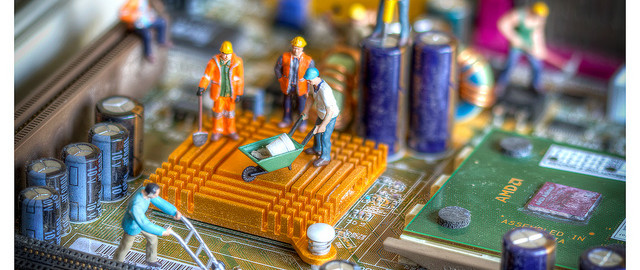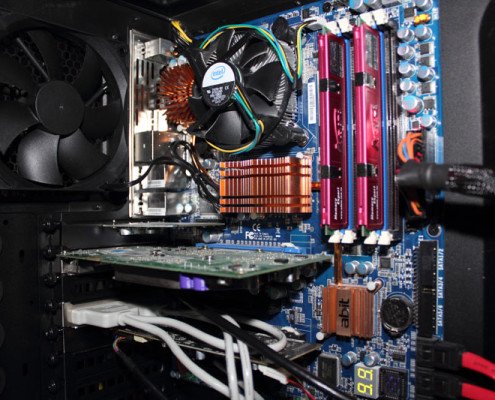8 Things happening inside your computer box
8 Things happening inside your computer box
By Jeandre de Beer / Kim Komando
When your computer is working well, the parts inside work together to help you surf the Web, organize and edit photos, type documents and anything else you use it for.
Most of the times we do not think about the multiple different parts a computer has. When you do remember is when something goes wrong.
If your computer suddenly stops working and you need to purchase a new computer or upgrade your current one – That’s when you enter a world of numbers and acronyms: CPU, RAM, eSATA, Gigabit, 802.11 … the list is endless.
Once you get past the letters and numbers, understanding what these parts actually do isn’t too hard.
Let’s see how a computer actually works.
1. CPU
The central processing unit is the part of the computer that “computes.” Most people just call it a CPU or processor.
The processor does the heavy lifting. It takes in numbers, does some calculations and returns other numbers.
A modern processor can do billions of calculations in a very short time. It’s hard to overstate just how amazing modern processors are; billions and billions of switches – known as transistors – crammed in a space the size of a thick postage stamp.
Many CPUs today have multi-core processors which put two or more CPU “cores” – the part that does the work – in a single CPU package. That allows us to get more performance with slower processor cores.
The benefit of more cores is better multitasking. Several cores can be working on separate tasks simultaneously. A slower multi-core processor can often accomplish more than a fast single-core processor.
The two most common types of multi-core processors are dual-core and quad-core. Dual-core processors have two cores, while quad-core processors have four. However, there are processors with as many as eight or more.
There are two major processor manufacturers for computers: Intel and AMD. AMD was big back in the mid 2000s, Intel has dominated the market since.
2. MOTHERBOARD
The processor needs to communicate with graphic cards, hard drives, RAM and lots of other components. That’s the job of the motherboard.
If you open up a computer, the motherboard is the large circuit board where the power supply, drives, RAM, add-on cards, the processor, external drives and everything else plugs into place.
There are multiple motherboards and chipsets available for every type of processor. Unless you’re building the ultimate gaming rig, you don’t have to worry about specific numbers.
Instead look for the features you want – like USB 3.0 or eSATA.
3. GRAPHICS
The graphics card is what turns information from the CPU into visuals for you to look at. There are two types of graphics cards: integrated and add-on.
Integrated graphics means the graphic card is built into the motherboard or processor. Both Intel and AMD’s newest processors have built-in graphics that are good for basic computer tasks.
Add-on graphics cards are third-party cards added to a computer. They’re better for serious gaming, media work and running multiple monitors.
AMD and Nvidia are the two big names in add-on graphics cards.
To connect a graphics card to a monitor or screen, there are several connection types. VGA is the oldest, but it’s still in use. DVI is newer and has much better quality. However, both are gradually being replaced by HDMI.
If you’re buying a graphics card or monitor, make sure the connectors match up with your existing card or monitor. For low-cost monitors that only have VGA, you can get an adapter to make it work. If you plan to plug your computer into a TV, HDMI is a must.
4. RAM
RAM stands for “random access memory,” but it’s usually just called memory.
Physically, RAM come in “sticks” and plug into slots on the motherboard. When the computer is running, RAM acts as a fast, temporary storage space for information you use frequently.
Do you ever notice your computer is slow the first time it opens a program, but after that the program loads up quickly? That’s because your computer moved the program into RAM.
For any modern computer, you want at least 4 gigabytes of RAM. If you have an older computer with less than 4GB, an upgrade is definitely in order.
If you’re doing heavy graphics work or video editing, you’ll also want 8GB or even 16GB of RAM.
While RAM is fast, it does have some drawbacks. When it loses power, the information it stores is lost. That’s why computers also have permanent storage.
5. HARD DRIVE
The hard drive is what stores all of the information on your computer. It’s much slower than RAM, but it holds a lot more data.
When your computer starts, most of the boot time is spent moving information from your hard drive into RAM. The more information it has to move, the longer your startup takes.
There are two types of hard drives: HDD and SSD.
HDD stands for hard disk drive. This is a conventional drive that uses spinning metal platters to hold and retrieve information. HDDs are cheap and store a lot of information – up to a thousand of times more than your computer’s RAM – but tend to fail or break easily.
HDDs are very inexpensive for the size. Most laptops will come with at least a 320 gigabyte drive. More are shipping with 500GB drives. Desktops can have 500GB to a 4,000GB – also called 4 terabytes – or more.
SSD stands for solid-state drive. Unlike HDDs, SSDs have no moving parts. That makes them faster and sturdier than regular hard drives. However, they also store less and are much more expensive.
The price is dropping, though.
Still, you don’t get as much space as an HDD. If you have an SSD and run out of space, grab an external HDD. These don’t cost much but will hold your additional data easily.
Sometimes when you’re shopping for an HDD, you will see an RPM number. As with all mechanical equipment, RPM stands for “rotations per minute.” It’s how fast the hard drive’s platters spin.
On a laptop, this number will be either 5,400RPM or 7,200RPM, but more often 5,400RPM. That makes them slower to access information, but they use less energy. That’s better for battery life, and the speed difference usually isn’t noticeable.
Desktop drives are typically 7,200, however some go as high as 10,000.
You should also know how hard drives connect to the motherboard. In the past they used a system called IDE, but now they use Serial ATA, or SATA. SATA is much faster.
If you open up a computer and see a 40-pin connector with a gray cable, then your hard drive is IDE. If it’s a very thin connector with a red cable, then it’s SATA.
6. OPTICAL DRIVE
Optical drives is another name for a CD/DVD/Blu-ray drive.
Optical drives also use IDE and SATA connectors, like hard drives.
Many lighter laptops are dropping the optical drive. If you still need one, you can buy an external model that plugs in via USB.
7. NETWORKING
A big part of computers is networking. That’s what allows computers to communicate with each other and get online. In fact, the Internet is basically one giant, complicated network.
Desktops have built-in wired networking, while laptops have built-in wired and wireless networking.
A wired network port is also called an Ethernet or LAN port. It looks like a wide telephone connector. Every modern Ethernet connection can transfer up to 100 megabits per second.
That’s fine for most situations. For people who need more, 1,000Mbps, or Gigabit Ethernet, connections are also available. This is good if you’re moving big files around your network.
However, you will need a router that supports gigabit Ethernet. Your other computers will need gigabit connections as well. Otherwise, the extra speed is wasted.
8. USB
Computers come with many types of connections. USB, or Universal Serial Bus, is one of the most important connections. You use it to connect mice, printers and external drives.
USB comes in a few different types, but the most popular are 2.0 and 3.0. USB 2.0 is still widespread and will work with any gadget.
However, the new standard is USB 3.0, which is blazing fast with speeds up to 5 gigabits per second, which is 10 times faster than 2.0. Many computers now come with a mix of USB 2.0 and 3.0.






Leave a Reply
Want to join the discussion?Feel free to contribute!